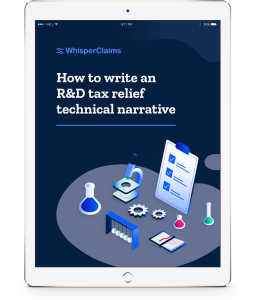Top 5 mistakes in R&D tax relief claims and how to avoid them
Share this article
Last spring, WhisperClaims launched two new features aimed at helping our clients:
- Understand their claims’ risks
- Get more help from us in working out how to improve their risk assessment through our claim review service.
Since launching the claim review service, we’ve carried out over 90 claim reviews—that’s 10% of the claims prepared through the platform!
Reflecting on all of these reviews, we noticed that many of them have the same mistakes and weaknesses, so to help you with your claim preparation here are the top five issues and how to fix them.
Top 5 issues preparing R&D tax claims
5) Incorrect treatment of grants
At number five we have a perennial favourite: getting grants wrong.
In claim reviews we’ve seen everything from including grants as a cost of the R&D, to including the total grant awarded rather than the amount received, to stating in project descriptions that grants were received but then not including the grants anywhere else in the claim.
Happily, issues with grants are usually very quick and easy to fix. Generally, all you need to do as advisor is to step back, take a breath, and then make sure that you have:
- Asked your clients about any and all grants received
- Made sure to include them as grants, even if none of the funding was used for R&D.
The WhisperClaims app does most of this for you, so long you take the time to assess the grants fully and add the figures at the correct time.
4) Ambiguous subcontracted R&D
At number four, we have claims that are unclear about whether the R&D was done under contract. We’ve seen many claims that state that the company did not work as a subcontractor, or that the company did work as a subcontractor but no R&D was involved in this work…only for the project descriptions to go into detail about whom the work was done for!
To make sure that there’s no confusion about whether the R&D would be classed as subcontracted, first of all you need to understand the rules around subcontracted R&D.
Once you’ve got that straight and have assessed each project to work out which, if any, would be classed as subcontracted R&D, you need to decide how to describe the project to avoid any contradictions.
Focussing on the underlying technology (more on this later!) will help with this; if the work is not subcontracted R&D, there shouldn’t be any need to mention contracts or customers in the description.
3) Contradictions
Building on number four and five, we have contradictions. Whether that comes from:
- Grants
- Subcontracting
- Stating that the work was done in an area of science and then describing work done in a different area
- Including costs that don’t line up with the accounts
Including contradictory information in a claim casts doubts on the veracity of a claim and invites questions from HMRC.
The easiest way to avoid contradicting yourself is to have a robust and repeatable process for pulling together claims to make sure that all of the inputs into a claim make sense, and everything is sense-checked before being sent to HMRC.
The WhisperClaims app is ideal for introducing a process to claim preparation, and the structured question set ensures that all of the right questions are asked, every time.
2) Over-inflated cost apportionments
The second most common mistake we see in claims we review is overinflated cost apportionments—whether that is staff members apportioned at 100%, or well-established manufacturing companies including 50% of their raw materials.
This can be a big red flag to HMRC.
The underlying issue here is usually a misunderstanding about what costs can be included. It’s important to only claim for the costs of eligible R&D activities, and only for the time spent resolving technical uncertainties.
Costs incurred on a project outside of these restrictions are not eligible and cannot be included.
1) Not focussing on the underlying technological advances
In at number one is the feedback we give most often: project descriptions being too focussed on commercial and logistical aspects of the project, and neglecting to address the underlying technical advances and technological uncertainties that made the commercial outcomes possible.
To overcome this you need to ensure that you exclude any information that describes commercial aspects of the project, and focus exclusively on the science or technology. HMRC don’t actually want or need to know anything about the eventual applications of the advance, so there’s no need to include any information about that.
Need help with writing an R&D tax relief technical narrative?
Learn what HMRC are looking for when you present the technical baseline, technical advance, technological uncertainties and technological resolutions—the key components of your claim. And of course you’ll also get to see how WhisperClaims can help you to navigate the complexities of the scheme.






